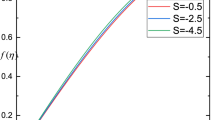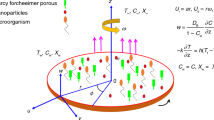Abstract
The interaction between disturbances in a compressible boundary layer in the presence of distributed mass transfer (injection or suction) through a permeable porous wall is considered in the linear and nonlinear approximations (weakly nonlinear stability theory). The regimes of moderate and high supersonic velocities (Mach numbers M = 2 and 5.35) are studied. The boundary conditions for the disturbances on a permeable wall are derived with account for the gas compressibility in pores and the presence of a suction chamber. Maximum pore dimensions, at which the surface properties have no effect on the disturbance characteristics, which are stabilized upon suction and destabilized upon injection, are determined. When the surface properties are taken into account, intense growth of the first-mode vortex disturbances occurs, which can completely undo the stabilizing effect of the suction. Injection leads to the vortex and acoustic mode destabilization on the linear range and the enhancement of the nonlinear processes on the transitional range.
Similar content being viewed by others
References
H. Schlichting, Boundary Layer Theory, McGrow-Hill, New York (1968).
A.V. Boiko, G.R. Grek, A.V. Dovgal’, and V.V. Kozlov, Turbulence Generation inWall Flows [in Russian], Nauka, Novosibirsk (1999).
S.A. Gaponov and A.A. Maslov, Development of Disturbances in Compressible Flows [in Russian], Nauka, Novosibirsk (1980).
S.A. Gaponov and N.M. Terekhova, “Stability and Three-Wave Interaction between Disturbances in a Supersonic Boundary Layer with Mass Transfer on the Wall,” Teplofiz. Aeromekh. 19, 301 (2012).
S.A. Gaponov, N.M. Terekhova, and B.V. Smorodskii, “Three-Wave Interactions between Disturbances in a Hypersonic Boundary Layer,” Vestn. Novosib. Gos. Un-ta. Ser. Fizika 3(2), 39 (2008).
S.A. Gaponov and N.M. Terekhova, “Three-Wave Interactions between Disturbances in the Hypersonic Boundary Layer on Impermeable and Porous Surfaces,” Fluid Dynamics 44(3), 362 (2009).
S.A. Gaponov and N.M. Terekhova, “Linear Evolution and Interaction of Disturbances in the Compressible Boundary Layers on Impermeable and Porous Surfaces in the Presence of Heat Transfer,” Fluid Dynamics 46(3), 399 (2011).
S.A. Gaponov and B.V. Smorodsky, “Linear Stability of Supersonic Boundary Layer on Porous Surface,” in: Recent Advances in Fluid Mechanics and Aerodynamics, World Scientific and Engineering Academy and Society, Moscow (2009), p. 68.
D.A. Bountin, A.N. Shiplyuk, A.A. Maslov, and N. Chokani, “Nonlinear Aspects of Hypersonic Boundary Layer Stability on a Porous Surface,” in: 42nd AIAA Aerospace Sci. Meeting and Exhibition, Reno, NV. 2004 (2004).
S.A. Gaponov, Yu.G. Ermolaev, A.D. Kosinov, V.I. Lysenko, N.V. Semenov, and B.V. Smorodskii, “Effect of the Porous Coating Depth on the Stability and Transition of a Supersonic Flat-Plate Boundary Layer,” Teplofiz. Aeromekh. 19, 555 (2012).
Yu.S. Kachanov, “Physical Mechanisms of Laminar-Boundary-Layer Transition,” Annu. Rev. Fluid Mech. 26, 411 (1994).
M.B. Zel’man, “Nonlinear Development of Disturbances in Plane-Parallel Flows,” Izv. Sib. Otd. Akad. Nauk SSSR. Ser. Tekhn. Nauk No. 13(3), 16 (1974).
S.A. Gaponov and I.I. Maslennikova, “Subharmonic Instability of a Supersonic Boundary Layer,” Teplofiz. Aeromekh. 4, 1 (1997).
S.A. Gaponov and N.M. Terekhova, “Evolution of High-Intensity Disturbances in a Supersonic Boundary Layer,” Aeromekh. Gaz. Din. No. 1, 28 (2003).
F.B. Daniels, “On the Propagation of Sound Waves in a Cylindrical Conduit,” J. Acoust. Soc. Amer. 22, 563 (1950).
S.A. Gaponov, “Effect of the Properties of a Porous Coating on the Boundary Layer Stability,” Izv. Sib. Otd. Akad. Nauk SSSR. Ser. Tekhn. Nauk No. 3(1), 21 (1971).
S.A. Gaponov, “Gas Compressibility Effect on the Stability of the Boundary Layer over a Permeable Surface at Subsonic Velocities,” Zh. Prikl. Mekh. Tekhn. Fiz. No. 1, 121 (1975).
Additional information
Original Russian Text © S.A. Gaponov, N.M. Terekhova, 2013, published in Izvestiya Rossiiskoi Akademii Nauk, Mekhanika Zhidkosti i Gaza, 2013, Vol. 48, No. 6, pp. 59–71.
Rights and permissions
About this article
Cite this article
Gaponov, S.A., Terekhova, N.M. Controlling supersonic boundary layer stability by means of distributed mass transfer through a porous wall. Fluid Dyn 48, 761–772 (2013). https://doi.org/10.1134/S0015462813060070
Received:
Published:
Issue Date:
DOI: https://doi.org/10.1134/S0015462813060070




